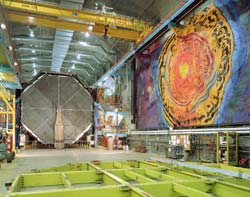This area deals with the fundamental laws and building blocks of nature and how they interact, the properties and the behavior of matter, and research into space and time and their structures.
innovations-report provides in-depth reports and articles on subjects such as astrophysics, laser technologies, nuclear, quantum, particle and solid-state physics, nanotechnologies, planetary research and findings (Mars, Venus) and developments related to the Hubble Telescope.

When NASA launches its Space Infrared Telescope Facility (SIRTF) – the agency’s fourth ‘Great Observatory’ – later this week, astronomers around the world will be looking forward to using one of the most powerful time machines ever built.
Among those anticipating the opportunity to look back billions of years to an era when the universe was in its youth are Professor Michael Rowan-Robinson (Imperial College London) and Dr. Sebastian Oliver (University of Sussex), who will be participating in

Europe is going to the Moon for the first time! In just over two weeks the European Space Agency’s (ESA) lunar probe, SMART-1, begins its journey to the Moon. Due to be launched from Kourou in French Guiana on 3rd September (12.04 a.m. 4th September BST) SMART-1 will be powered only by an ion engine which Europe will be testing for the first time as the main spacecraft propulsion. Onboard will be D-CIXS, an X-ray spectrometer built by scientists in the UK, which will provide information on what the

Today, (August 14th), sees the start of data collection on the Main Injector Neutrino Oscillation Search (MINOS) detector, situated in the Soudan iron mine, Minnesota, USA. UK particle physicists, working within an international collaboration, will use the MINOS detector to investigate the phenomenon of neutrino mass – a puzzle that goes to the heart of our understanding of the Universe.
Neutrinos are pointlike, abundant particles with very little mass. They exist in three types or ‘flavour

Scientists from the University of Strathclyde, collaborating with an international team from Imperial College, Rutherford Appleton Laboratory(RAL), ITU (Karlsruhe) and the University of Jena, have successfully turned the radioactive isotope Iodine-129, a major waste product in the nuclear power industry, into the more friendly isotope Iodine-128 using laboratory lasers. This is the first time an isotope has been transmuted. They announced their discovery today in The Institute of Physics journal Jour

Researchers from the National Institute of Standards and Technology (NIST) and Boston University have demonstrated a detector that counts single pulses of light, while simultaneously reducing false or “dark counts” to virtually zero.
Reported in the July 28, 2003, issue of Applied Physics Letters*, the advance provides a key technology needed for future development of secure quantum communications and cryptography.
Quantum communications and cryptography is a codemaker’s Holy Grai

ESA’s Mars Express is due to arrive at Mars in December 2003, and its Beagle 2 lander will be making a touchdown in the middle of the Martian winter. Will it see a ’’white Christmas’’ on the Red Planet? Also, if humans one day go to Mars, would they need to take a sunscreen?
Over its four-year lifetime, Mars Express will be returning data to refine the latest computer models of the Martian climate. It will be closely watching the clouds, fog, dust devils, and storms,